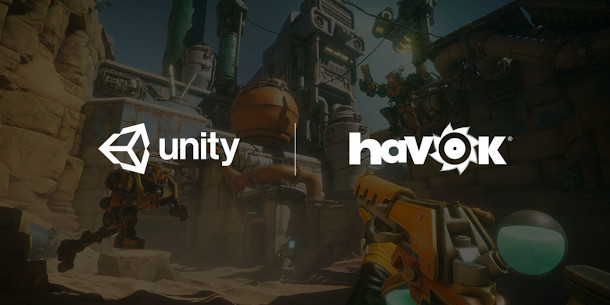Real-time ray tracing, Havok physics due in Unity this year
Originally posted on 19 March 2019. Scroll down for news of the preview release of Havok physics.
Unity Technologies has announced new real-time ray tracing capabilities for its Unity game engine during its keynote at the GDC 2019 conference.
The functionality, which is built on Nvidia’s RTX technology, will become available as a public preview later this year, as will a new physics system based on Havok’s middleware.
Real-time ray tracing: due Fall 2019
Unity’s implementation of real-time ray tracing is based around RTX, Nvidia’s hardware implementation for the DirectX Raytracing API, available in its new Quadro RTX, Titan RTX and GeForce RTX GPUs.
The system is built on top of the new High Definition Render Pipline (HDRP), introduced in Unity 2018.2, using C# scripts and shaders.
The firm’s demo of the technology (embedded above), which was created with Nvidia and BMW, intercuts footage of a real car with a CG car rendered at 4K resolution in Unity using the HDRP.
Unity’s blog post describes the rendering work as being done at “interactive frame rates” using Nvidia’s GeForce RTX 2080 Ti gaming GPUs.
During the corresponding section of the keynote, which starts at 02:02:40, you can see a 13-million-poly car interior scene being manipulated in real time on a single-GPU laptop.
Real-ray tracing will become available in an experimental build of the HDRP on GitHub on 4 April 2018, with a full public preview due in ‘fall 2019’, presumably as part of Unity 2019.3
Epic Games is already supporting RTX-based ray tracing in Unreal Engine 4.22, currently in public beta.

New Havok physics system: due by Summer 2019
Other features announced during the keynote include new physics systems created using the Data Oriented Technology Stack (DOTS), Unity’s collective name for a set of coding features introduced in Unity 2018.1.
Developed in collaboration with Havok, Unity Physics is described as a “simple, lightweight physics engine”, and is being implemented alongside the Havok engine itself.
Both use a single shared data layer, making it possible for developers to “build … content and game code once and have it work seamlessly with both solutions”.
You can see a demo around 01:54:30 in the recording of the keynote.
Unity Physics is described as being available as a preview package – although, at time of posting, it doesn’t seem to have gone up either on the Unity beta site or GitHub.
Havok Physics is due “this summer”, which would coincide with the release schedule for Unity 2019.2
New mobile and augmented reality toolsets: due in Spring 2019
Unity also announced another upcoming preview package, Adaptive Performance, intended to give developers of mobile titles information about thermal performance on the device.
The technology, developed in partnership with Samsung, shows whether performance is currently CPU or GPU-bound, enabling the game to adapt dynamically to maintain a consistent frame rate.
It will be available for Samsung’s Galaxy S10 and Fold smartphones, and will “expand to many more devices”.
The preview will be available “in a few weeks” as part of the Unity 2019.1 beta.
It will be joined by AR Remote, which streams sensor data from an augmented-reality-enabled mobile directly to the Unity editor, enabling devs to see changes in real time without publishing to the device.
AR Remote forms part of Unity’s platform-agnostic AR Foundation framework, so it should work with both ARKit/iOS and ARCore/Android devices.
Other developments announced at GDC include Game Foundation, an upcoming set of readymade components for mobile games, including inventory, save state and micropayment systems; and the beta launch of Unity Distribution Portal (UDP) for publishing mobile titles to app stores worldwide.
Updated 7 November 2019: Havok Physics is now available as a preview package for Unity 2019.1+. Find more details in Unity Technologies’ blog post announcing the integration and the online documentation.
DXR ray tracing became available in preview as part of the Unity 2019.3 beta earlier this year.
Pricing and availability
Unity 2019.3 is available in beta for Windows 7+ and macOS 10.12+.
The software is available on a rental-only basis: free Personal subscriptions have a non-editable splash screen and can be used by anyone with revenue of up to $100,000/year.
Paid Plus and Pro plans currently cost $35/seat/month and $125/seat/month respectively.
Read more about upcoming features in Unity on Unity Technologies blog
